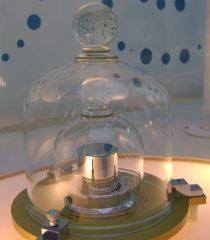Science is about measurements. Otherwise it’s just philosophy. “Bring some potatoes from the market” is meaningless in science. “Bring 1 kg potatoes” is meaningful.
But then how to decide ‘how much is 1 kg’? How should we measure it? A very basic question but pretty interesting!
Long ago in history, when we did not know about ‘the kilo’, people used seeds or such things to measure the mass. And then finally the first significant scientific attempt to define the units was done in 1799, when metric system was introduced in France.
To make the whole world understand ‘how much is 1 kg’, a platinum-iridium cylinder was manufactured (1799)!! It is called International Prototype Kilogram (IPK). And of course we had to take a lot of care of this piece!!
We don’t want the entire universe to suffer if its kilo is stolen!!

Only one cylinder is of course not sufficient for all of us in the world. So we have to make copies. And copies of the copies and copies of the copies of the copies. And finally we get this for measuring our potatoes:

The IPK is rarely used or handled. Copies of the IPK are kept by national metrology laboratories around the world.
These copies of IPK were compared with the original IPK in 1889, 1948, and 1989 to provide traceability of measurements of mass anywhere in the world back to the IPK.
And surprisingly, over all the years, drifts of ONLY upto 0.00000008 kilograms per year in the national prototype kilograms relative to the international prototype kilogram have been detected!!
And the worst part was, there was no way of determining whether the national prototypes were gaining mass or whether the IPK was losing mass!
That means we no longer ‘know’ ‘how much is one kilo’!
And that’s horrible!!
To overcome this, national laboratories were urged to investigate ways to know the 1 kg without using any platinum cylinder. Or any other object as such!
A Kibble balance (previously, watt balance ) is an electromechanical measuring instrument that measures the weight of a test object very precisely.

This instrument measures weight of an object by measuring the the electric current and the voltage needed to lift it. (This is just the basic idea. Actual working and measurement has many complexities!)
This idea of measurement and the actual instrument (balance) has evolved over many years [from Precision Ampere balance, 1927 to Kibble balance 2016]. It was declared as sufficiently accurate in November 2018. And a new definition of kilo is accepted based on measurement of Planck’s constant. With this we would know ‘how much is 1 kg’ even if we lose the platinum cylinder kept at Paris!
And that is a great achievement!
(Of course, for that you must have the kibble balance, a method to measure one second by hyperfine transition frequency of the caesium-133 atom and a method to measure one meter by measuring the distance covered by light in vacuum in 1/299792458 sec and an instrument to measure the voltage and current very accurately and many other instruments to measure many other things!)
With this method to measure the mass, the 2019 redefinition of units is based on universal constants like speed of light, Planck constant, elementary charge e, Boltzmann constant k, the ground state hyperfine structure transition frequency of the caesium-133, luminous efficacy Kcd of monochromatic radiation of frequency 540×1012 Hz and Avogadro constant.
The new definitions will come into force on 20 May 2019 which is World Metrology Day!
Personally I would still prefer the cylinder!! What about you?
– Rahul & Udita Ogale

I do agree with you.
LikeLike
[…] The new definition of kilogram (2019) – In simple words! […]
LikeLike